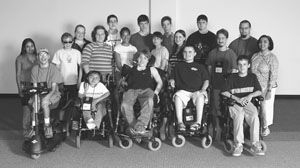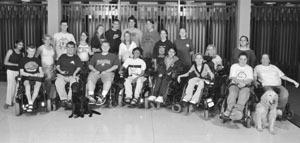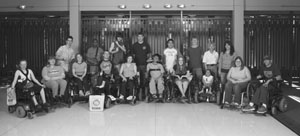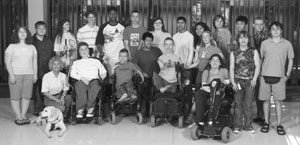Chapter 2: How to DO-IT: An Overview
"I hope DO-IT will help me learn how to get the accommodations I need to help me reach my goals." –DO-IT Scholar
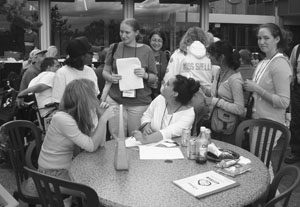
Creating and running the DO-IT Scholars program takes a team! This chapter includes details about student recruitment, the application and selection processes, and the overall program sequence for participants. The content is adapted from the publication DO-IT Scholars (DO-IT, 2006a). View the video How DO-IT Does It to better understand planning and implementation steps. It can be purchased from DO-IT in DVD format or freely viewed online on the Resources page.
The DO-IT Scholars
DO-IT Scholars are college-capable students with disabilities who have leadership potential. They typically begin their participation as Scholars at the end of their sophomore year of high school. Scholars have a variety of disabilities, including visual impairments, hearing impairments, mobility impairments, health impairments, attention deficits, Asperger's syndrome, and learning disabilities. Some students receive special education services in their schools. Many use academic accommodations to access curriculum materials and classroom activities.
As part of the DO-IT Scholars program, high school students:
- learn to select and use adaptive technology
- experience college life on a university campus
- network with peers and working professionals with disabilities
- learn to identify reasonable accommodations at school and in the workplace
- explore careers and the world of work
- gain prerequisite knowledge to enter and succeed in college and challenging careers
The video and complementary publication entitled Snapshots: The DO-IT Scholars provide an overview of the program. They are freely available from DO-IT (with video in DVD format) or online on the Resources page.
Recruitment
To recruit students, email messages and information packets with applications are sent to high schools, school districts, and community organizations throughout Washington State, the region for which the DO-IT Scholars program is currently funded. DO-IT staff members participate in conferences year-round to distribute additional applications and brochures. Press releases are sent to relevant media to announce the application process and encourage students to apply. Staff members also make personal phone calls to under-represented areas of the state to speak with special education teachers and other educators about the DO-IT Scholars program. Since many Scholars, Mentors, and parents know other people who have disabilities, the entire DO-IT community is encouraged to recruit applicants.
Application
High school sophomores and juniors with disabilities who are residents of Washington State are encouraged to apply by January to be considered in the first round of selection by the DO-IT Advisory Board. Priority is given to students in their sophomore year of high school. Twenty Scholars are accepted each year, and their multiple years of program involvement are funded by Washington State. Occasionally an organization chooses to fund an additional Scholar from another state.
Each student who applies to be a DO-IT Scholar must complete a student application and provide a (a) school transcript, (b) recommendation from a high school teacher or administrator, and © letter of recommendation and consent from a parent or guardian. A sample DO-IT application form can be found in Appendix A.
Selection
The DO-IT Advisory Board selects the DO-IT Scholars. The Board consists of community members, professionals, and parents of students with disabilities. Each Board member reviews applications and recommends participants according to the following criteria:
- Interest in pursuing college and a challenging career, as evidenced by personal responses to application questions and by letters of recommendation.
- Aptitude to succeed in college, as determined by letters of recommendation and by academic record.
- Motivation to participate in the program, as evidenced by personal responses to a question about desire to participate and by letters of recommendation.
- Potential benefit to be gained from the program and contribute to diversity of the participant pool, as evidenced by all application materials.
"DO-IT will help me see what living on a college campus is like for a person with Cerebral Palsy. I hope to determine whether I want to live on campus or continue living at home while going to school." –DO-IT Scholar
DO-IT Advisory Board members choose participants who will benefit the most from the program and represent a wide variety of disabilities and other characteristics. Selected applicants are notified in the spring by phone and mail. Applicants who are not accepted are notified by mail and given the option of applying the following year if they continue to meet eligibility requirements. All applicants who are not accepted as DO-IT Scholars are urged to join the DO-IT Pals online community and participate in other DO-IT activities.
Students become Phase I DO-IT Scholars once accepted into the program. Phase I Scholars begin interactions with DO-IT staff members, receive computer technology in their homes, and are introduced by email to the electronic community of peers and mentors.
DO-IT Scholar Activities
The figure below illustrates a DO-IT Scholar's typical progression through the program. The following section describes program components in more detail.
DO-IT Scholar Typical Participation Timeline
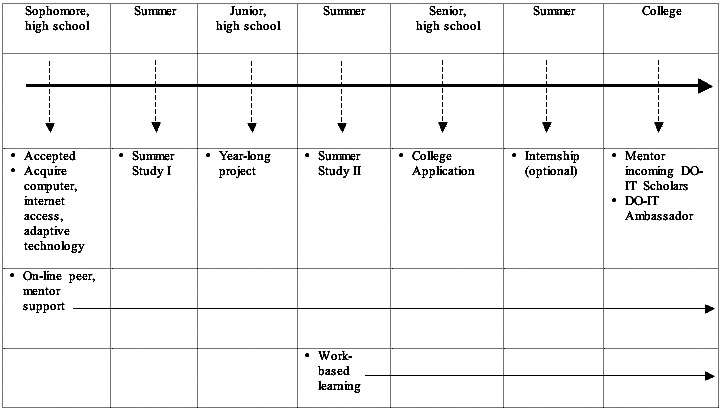
"In Summer Study I saw what college life is really like, and met people who are going through similar situations to mine." –DO-IT Scholar
Phase I (Year One) Scholars
Phase I Scholars are high school students in their sophomore or junior year. In Phase I, DO-IT Scholars participate in the following activities:
Internetworking. DO-IT Scholars learn to use computers to enrich their education and to explore academic and career interests via the Internet. From home, they communicate electronically with DO-IT Mentors and other participants using computers, the Internet, and, as needed, special assistive technology. DO-IT Scholars who do not have the necessary technology are loaned computer equipment and software while they participate in program activities.
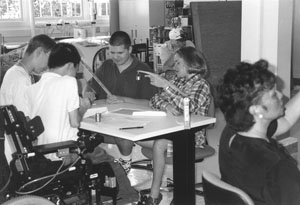
Mentoring. Frequent electronic communications and personal contacts bring Scholars together with DO-IT Mentors to facilitate academic, career, and personal achievements. Mentors are college students, faculty, and professionals in technology and other challenging fields, many with disabilities themselves.
Summer Study I. During a two-week, live-in summer program at the University of Washington in Seattle, DO-IT Scholars participate in academic lectures and labs, live in residence halls, learn about how to secure postsecondary accommodations, and practice skills that will help them be independent and successful in a college setting.
"I am looking forward to being a part of the DO-IT program so that I can learn about technology that will assist me with my disabilities and meet new people." –DO-IT Scholar
Phase II (Year Two) Scholars
Phase II DO-IT Scholars are high school juniors or seniors. Phase II Scholars are supported with information about college application procedures, entrance requirements, scholarships, and additional tips and resources to help them prepare for college. They participate in the following activities:
Projects. DO-IT Scholars apply their interests, skills, and knowledge to design and complete independent and team projects. DO-IT Mentors and staff act as resources.
Internetworking and Mentoring. DO-IT Scholars develop and practice communication and leadership skills by acting as peer mentors for incoming Phase I DO-IT Scholars. Communication occurs in-person during the Summer Study program and electronically throughout the year.
Summer Study II. DO-IT Scholars return to the University of Washington campus for a one-week, live-in summer program to create and complete group projects of personal interest. They also continue to prepare for college and explore careers.
Phase III (Year Three) Scholars
Phase III includes opportunities for DO-IT Scholars to mentor younger Scholars and otherwise contribute to the DO-IT community. Examples of individual activities include developing campus programs for students with disabilities, participating on DO-IT panels, contributing to the DO-IT newsletter, and assisting with summer camps.
Life Stages of DO-IT Participants
Level Participants
High School DO-IT Scholars College
College DO-IT Ambassadors
DO-IT Mentors
Careers DO-IT Ambassadors
DO-IT Mentors
Ambassadors (after high school graduation)
A Scholar who graduates from high school can become a DO-IT Ambassador. An Ambassador helps with program activities, participates in electronic communications, and mentors Scholars. Ambassadors are eligible to become interns during the live-in Summer Study program. Interns serve as peer mentors and support DO-IT staff with a range of duties and responsibilities during the summer program.
For more information about the DO-IT Scholars program, view the video and consult the publication titled DO-IT Scholars. They can be found online, along with other DO-IT videos and publications, on the Resources page. They can also be obtained (with video in DVD format) from DO-IT.
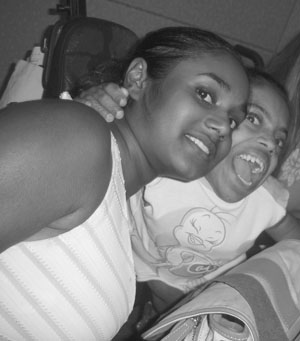
Sample Documents
Consult the following Appendices for samples of application forms and information sheets for the DO-IT Scholars Program.
- Appendix A: Program Application and Parent/Guardian Consent
- Appendix B: Participant Information
- Appendix C: Parent/Guardian Consent for Summer Study Activities
- Appendix D: Media Release
- Appendix E: Volunteer Application Form
- Appendix F: Publications Release
What's Next
The next chapters describe how staff prepare DO-IT Scholars for participation and how major components of the program are developed, organized, and implemented.
